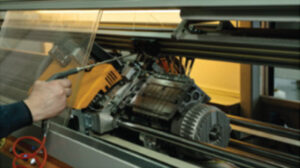Leverage Machine Guarding for Safety And Productivity
By: Erin Reilly, Contributor

Smooth extruded aluminum and clear panel material act as a protective guard for this mechanized equipment.
Moving parts and machinery are part and parcel of the manufacturing industry. Without them, nothing would be fabricated, extruded, drilled or assembled. But the caveat is that every machine has hazards, which are mechanical and non-mechanical. While machine automation has come a long way, manufacturing still requires people to operate and maintain these machines. Essential to the checklist in maintaining workers’ health and safety is machine guarding.
Machine guarding is the primary barrier between workers and machine hazards such as nip points, ejected material, rotating pieces, sparks, etc. The guarding requirements for something like a conveyor will differ from a saw or a press, and there are different kinds of guarding to consider as well. Some guarding can be unobtrusive, such as a laser scanner that will stop machinery if the beam is interrupted. Light curtains are a type of guarding that uses a soft physical layer as a barrier. This article focuses on hard machine guarding, which puts a rigid physical layer between the moving parts and the operator.
Machine guarding types
For example, a conveyor system has nip points where the rollers converge or where a conveyor belt wraps around a roller. These can be guarded by having rigid material around the conveyor’s edge to prevent anyone from accidentally reaching into the moving area.
Another type of effective machine guarding is a cage made from a frame and wire mesh material or a clear panel material with openings. Workers use the openings to reach in and manipulate the equipment while avoiding hazards. This type of guard is typically used for items like saws and presses. Wire mesh may be the best solution if the machine might eject flying debris or if the machine must be separated from the surrounding work area while retaining control access. The downside to wire mesh is that visibility of the machine is significantly reduced.
If visibility is required, a clear panel like acrylic or polycarbonate may be used. There are advantages and disadvantages to each of these materials too. While acrylic has higher clarity than polycarbonate, polycarbonate is stronger and does not crack as easily, making it easier to drill holes near the edges without a plastic-specific drill bit. Acrylic is less expensive than polycarbonate but has lower chemical resistance. Polycarbonate is not typically affected by oils or acids. A prime example of this material type would be a visor around a drill press for tapping screw holes or drilling through another material to make an access hole. The clear material lets the operator see what they are doing and where the end of the drill is so they can accurately perform their work.
Machine guarding benefits—safety and beyond
Proper guarding around any moving part is necessary to prevent company losses from both workforce and monetary standpoints. Because amputations represent some of the most catastrophic workplace injuries employees can experience, placing proper guarding around equipment reduces the likelihood of a worker suffering one of these events. The company will need to handle the time and cost for the injured employee’s days away from work plus workers’ comp reimbursement and disability, but first and foremost is to protect the employee from experiencing a traumatizing incident like an amputation.
In addition, machine guarding can improve workplace efficiency by giving workers the confidence to work more productively. Suppose there is an extra layer of safety—in the form of guards—between a press operator and the material they are drilling. The workers are more likely to perform the task in a timely fashion because they also have the visor and safety goggles for protection. An individual’s personal protective equipment, such as goggles, gloves and protective footwear, is always the last line of defense against a hazard. The more that machine guarding can help safeguard the individual, the better.
Use with care
On the same note, any guarding must not impede the usual function or operation of the equipment. Sometimes, without trying, employees are engines of efficiency and will want to do things in the simplest way possible. If the guarding is too complex or inconveniences the worker, they might circumvent the protective measures to accomplish what they feel is a more important task, thereby placing themselves at risk.
When used properly, machine guarding prevents injury and increases productivity. It creates a safer work environment for employees, improving their confidence and allowing for efficient completion of tasks involving automated and hand-operated machinery with moving parts. Some manufacturers make dedicated machine guarding, but for best results, consider a business specializing in framing and panel products that customizes machine guarding to the customer’s requirements. Anyone looking to secure their workers against injuries would benefit from seeking expertise in installing guards for their machinery. WMHS
Erin Reilly is a buyer at Motion Ai, a business unit of Motion focused on providing automation solutions. Since 2018, she has quoted and ordered industrial aluminum framing for safety, manufacturing and recreational applications. Erin also manages safety for her branch. For more information, visit ai.motion.com or motionind.biz/AiMachineGuarding22.



